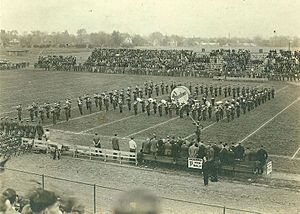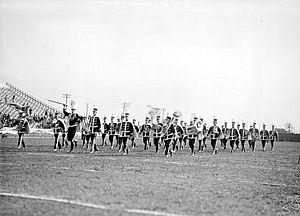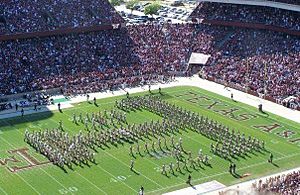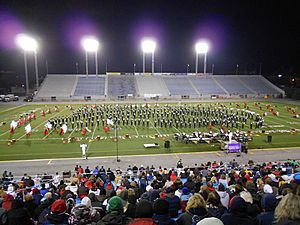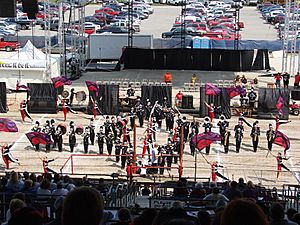Marching band facts for kids
A marching band is a group of musicians who play instruments while moving, usually marching. They often perform outdoors. Marching bands combine music with movement, like marching and other cool formations.
Their instruments are usually brass instruments (like trumpets), woodwinds (like flutes and clarinets), and percussion (like drums). The music they play often has a strong beat, perfect for marching. All marching bands wear special uniforms.
Besides performing in parades, many bands also put on exciting field shows. You might see these at American football games or during competitions.
Contents
History of Marching Bands
People have used drums and wind instruments on battlefields since ancient times. These early military bands helped soldiers march and boosted their spirits.
In the United States, modern marching bands are famous for performing at American football games. The oldest American college marching band, the University of Notre Dame Band of the Fighting Irish, started in 1845. They first played at a football game in 1887.
A big change happened in 1907. Paul Spotts Emrick, director of the Purdue All-American Marching Band, created the first "pictorial formation" on a football field. He saw birds flying in a "V" shape and thought a band could do something similar! This led to bands creating shapes and pictures on the field.
Also in 1907, the Marching Illini from the University of Illinois at Urbana-Champaign performed the very first halftime show at an American football game.
Around the same time, "fight songs" became popular. These songs are often linked to a university's band. Many high schools across the U.S. use famous college fight songs, like The Victors from the University of Michigan.
Over the 20th century, marching bands added more exciting elements. These included baton twirlers, majorettes, dance lines, and color guard (who spin flags).
After World War I, marching bands grew a lot in public schools. Military veterans who had played in service bands became music teachers. They brought wind music and marching bands into schools.
Marching bands also started to compete. The first national contest was held in 1923 in Chicago. Today, state and regional contests are very common.
Since the 1970s, many marching bands have started to look like modern drum and bugle corps. These are called corps-style bands. Some changes they adopted include:
- Marching: Instead of a high step, they often use a smooth "roll step." This keeps the musicians' bodies still while they move.
- Auxiliaries: They added "color guard" units. These groups spin and toss flags, rifles, and sabres, and use dance to add visual excitement.
- Percussion: Many percussion instruments, like xylophones and timpani, moved to a stationary "pit" at the front of the field. This pit now includes many different types of percussion.
- Competitions: Marching band competitions are judged like drum corps contests. They look at music, visual performance, percussion, guard, and overall effect.
Styles of Marching Bands
Marching bands come in different styles based on what they do, what instruments they use, and how they march.
Military Style
Military bands were the very first marching bands. They usually have brass, woodwind, and percussion instruments. They march in straight lines, always moving forward. Their music is played at a steady, fast pace (like 120–140 beats per minute) to help soldiers march together.
Today, you can still find military-style marching bands in some schools, like the Fightin' Texas Aggie Band from Texas A&M University. Many countries outside the U.S. also have strong military band traditions, especially in Latin America and Europe.
Corps Style
Corps Style bands are very similar to modern drum and bugle corps. Unlike military bands, corps-style bands change their step sizes often. This helps them create different shapes and designs on the field, which can be straight lines, curves, or scattered patterns. They play all kinds of music, from movie scores to pop songs.
Corps-style bands often have a "color guard" who spin flags, rifles, and sabres. They also use props, backdrops, and even costumes to make their shows more like a theatrical performance.
Another unique part of corps-style bands is the front ensemble (or "pit"). This includes instruments like xylophones, marimbas, and timpani. They might also use sound systems or electronic instruments like synthesizers.
Corps style is always changing, with new ideas coming from college bands, high school bands, and drum corps across the U.S. These bands often compete in big events like Drum Corps International and Bands Of America.
Traditional Style
Traditional Style bands, also called Show Bands, focus on entertaining the crowd, usually at football games. They perform before the game, at halftime, and sometimes after. Some show bands perform a new show for each game, while competitive ones perfect one show all season. Their shows often involve three to five songs with formations that move and change.
A well-known type of show band comes from historically black colleges and universities (HBCUs). HBCU bands use a high-stepping march and play R&B, hip-hop, and popular music. They also include amazing dance routines. Many HBCU bands have twirler lines or dancer lines. The 2002 movie Drumline shows these bands. HBCU bands are a huge part of African-American music culture and are often more popular than their football teams!
Another show band style is seen in many Big Ten Conference marching bands. These bands mix military and corps styles. They entertain audiences with traditional symphonic music, movie scores, jazz, or older pop songs, as well as some modern music.
Most show bands use traditional instruments like woodwinds, brass, and drums. Some also have a front ensemble and a color guard.
Carnival Bands
Carnival bands are a type of show band found in the United Kingdom. They march in time with the music and often take part in parades and competitions. They use brass and percussion instruments, and sometimes woodwinds. In the U.S., similar groups are called Parade bands and are common in Southern California.
Scramble Bands
Scramble bands (or 'Scatter' bands) are a fun variation of show bands. They don't usually march in time with the music. Instead, they "scramble" from one formation to another. They often add funny elements to their performances. Most bands in the Ivy League use this style.
Instruments in a Marching Band
The size and instruments in a marching band can be very different. Some bands have fewer than 20 members, while others have over 500!
The woodwind section often includes piccolos, flutes, soprano clarinets, alto saxophones, and tenor saxophones. Instruments like bassoons and oboes are rarely used on the field because they can easily get damaged, are hard to march with, and are sensitive to weather.
The brass section usually has trumpets or cornets; French horns or mellophones; tenor trombones; baritone horns or euphoniums; and tubas or sousaphones. Mellophones often replace French horns. Some large bands use flugelhorns and bass trombones. Special versions of brass instruments are made for marching, so their bells always face the audience.
The marching percussion (or drumline) usually includes snare drums, tenor drums, bass drums, and cymbals. They are in charge of keeping the beat for the whole band. All these instruments are made to be carried outdoors.
Bands with a front ensemble (or "pit") have stationary instruments. These can include timpani, xylophones, marimbas, and many other percussion instruments like tambourines, congas, and gongs. They might also use drum sets or electronic instruments like synthesizers. Sometimes, even electric guitars and bass guitars are used, often with special wireless systems or car batteries for power.
Images for kids
-
The University of Florida's marching band, The Pride of the Sunshine, performing in a parade
-
Kansas State University Marching Band marching on the football field at Bill Snyder Family Stadium in Manhattan, Kansas
-
Diagrammed example of marching band uniforms of the Big Ten athletic conference in the United States.
See also
 In Spanish: Banda de marcha para niños
In Spanish: Banda de marcha para niños


